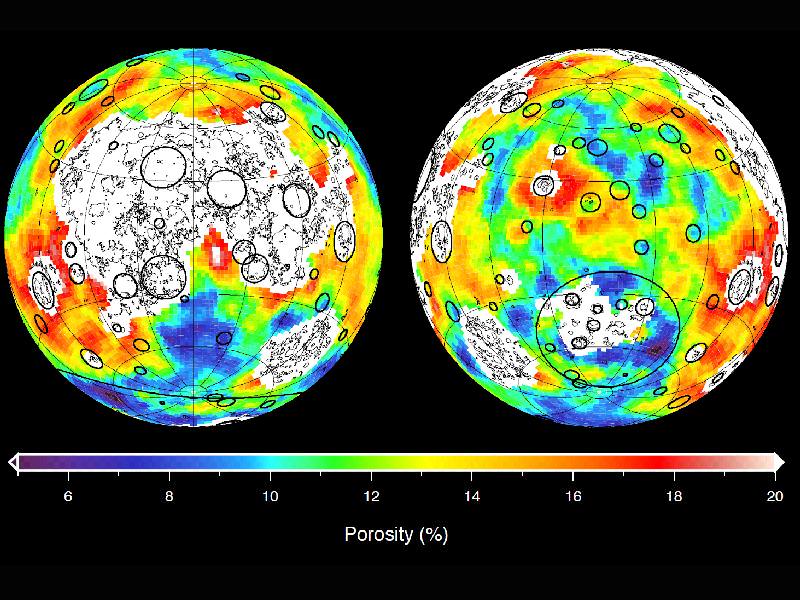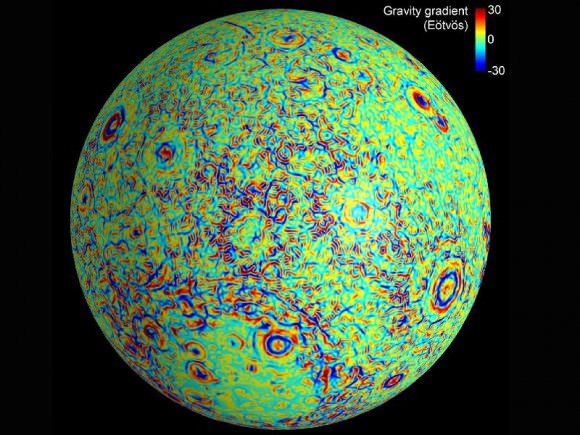This image shows a highly porous crust on the lunar surface, a consequence of fractures generated by billions of years of impact cratering. Credit: NASA/JPL-Caltech/ IPGP
From looking at the Moon’s surface, we know it has taken a beating from asteroids and comets pummeling its surface. But new details from the GRAIL mission reveal the lunar interior just below the surface has been walloped as well, and is almost completely pulverized. This surprising finding, along with the discovery of deep fractures, suggests that in its first billion years, the Moon may have endured a history of massive impacts, more than previously thought. By inference, this means Earth and other terrestrial planets in the Solar System endured huge early impacts, too.
“It was known that planets were battered by impacts, but nobody had envisioned that the [Moon’s] crust was so beaten up,” said Maria Zuber, Principal Investigator for the GRAIL mission. “This is a really big surprise, and is going to cause a lot of people to think about what this means for planetary evolution.”
The new GRAIL data agrees with recent studies that suggest that the Late Heavy Bombardment may have lasted much longer than originally estimated and well into the time when early life was forming on Earth. Additionally, this “late-late” period of impacts — 3.8 billion to 2.5 billion years ago — was not for the faint of heart. Various blasts may have rivaled those that produced some of the largest craters on the Moon, and could have been larger than the dinosaur-killing impact that created the Chicxulub crater 65 million years ago.
From GRAIL’s measurements, Zuber and her team have now stitched together a high-resolution map of the Moon’s gravity (read more about it in our previous article.)
But the resulting map also reveals an interior gravitational field consistent with an incredibly fractured lunar crust. Compared to the surface, the map of the interior looks extraordinarily smooth. Except for the large impact basins, the Moon’s upper crust largely lacks dense rock structures and is instead likely made of porous, pulverized material.
This moon map shows the gravity gradients calculated by NASA’s GRAIL mission. Red and blue correspond to stronger gravity gradients. Image credit: NASA/JPL-Caltech/CSM
GRAIL’s lunar gravity map has also revealed numerous structures on the Moon’s surface that were unresolved by previous gravity maps of any planet, including volcanic landforms, impact basin rings, and many simple, bowl-shaped craters. From GRAIL’s measurements, scientists have determined that the Moon’s crust, ranging in thickness from 34 to 43 kilometers, is much thinner than planetary geologists had previously suspected. The crust beneath some major basins is nearly nonexistent, indicating that early impacts may have excavated the lunar mantle, providing a window into the interior.
“If you look at surface of the Moon and how heavily cratered it is,” said Zuber during a press briefing on Wednesday from the American Geophysical Union conference, “that tells us that all terrestrial planets looked that way, but Earth’s history is not preserved because of atmospheric and erosional processes on our planet. So, if we want to study those early periods, we need to go somewhere else, and the Moon is the perfect place for that.”
Zuber said that from finding an incredible fracturing of the Moon’s upper crust, we now know the crust of other planets likely have these same fractures as well. “We have reason to believe that the fractures on the terrestrial planets are deeper, and perhaps as in case of the Moon, even into the mantle. This effects planetary evolution, such as how planets lose heat,” she said.
Fractures also provide a pathway for fluids.
“Mars has been theorized to have an ancient ocean, and we wonder where it went,” said Zuber. “The ocean could well be underground, and we’ve seen evidence of water underground on Mars. If there were ever microbes on the surface of Mars, they could have gone very deep, so this finding opens up possibilities like that, and really opens a window to the early stages of our Solar System and just how violent a place it was.”
In addition to GRAIL’s discoveries, Zuber said another major accomplishment has been the performance of the spacecraft themselves. To achieve the mission’s science goals, the two probes, which can travel more than 200 kilometers apart, needed to be able to measure changes in the distance between them to within a few tenths of a micron per second. But GRAIL actually outperformed its measurement requirements by about a factor of five, resolving changes in spacecraft distance to several hundredths of a micron per second.
“On this mission, with two spacecraft, everything had to go perfectly twice,” Zuber says, adding proudly, “Imagine you’re a parent raising a twins, and your children sit down at the piano and play a duet perfectly. That’s how it feels.”



The moon really took a beating no one imagined could be possible.
Is it possible for the late heavy bombardment to have caused the earth’s crust to have fractured and star the plate techtonics process? my understanding is none of the otber inner rocky planets show no sign of the crust acting in this way. Can anyone give an insite at all?
“ ‘It was known that planets were battered by impacts, but nobody had envisioned that the [Moon’s] crust was so beaten up,’ said Maria Zuber” __________________________________________________________
What surprises me as mere layman, is that scientists are surprised at the extent of the pulverizing, crust-fracturing violence the Moon suffered. Whatever your world-view, one cannot deny something
terrific engulfed the entire Solar System, from Neptune’s Triton (and beyond) to Mercury, with an intense, unbelievable ferocity, at some time in its momentous history.
What is really extraordinary, beyond standard explanations, is that among all those world-escapes of Sun-orbiting desolation – demolished, dislocated, or cast-aside moons; a fallen Ice Giant of dark encircling dwarfs; brother planets, either buried in acid shrouds of an interior hell, or torn and gashed, stripped of habitability, and dried-up like fossil of the frozen past, to Solar-elements exposed; or slammed into reverse motion by impossible blows; (????) amid all that, and more – one lone World stands like a country-garden place of tree-shaded home, alive with Spring-songs.
(Yes, a few small-covered, or large-buried wounds)
Yet, surreally, that one neatly-ordered location of warm color and living motion, is surrounded by a cold, sweeping expanse of a gray-cratered, artillery-pounded WW-I like landscape, silent in waste and shattered in ruin. Now that is what is really surprising (to put it mildly).
I can certainly deny that “something terrific engulfed the entire Solar System”, because it didn’t happen. The protoplanetary disk was a far more violent environment, and it produced the pristine terrestrials. This happened while the early Oort cloud was sheared and cut down to size between ~ 600 sister stars in the local pocket of the molecular cloud that birthed them.
What people believe happened then is predicted by the Nice model of our system. Jupiter’s and Saturn’s early migration towards the Sun captured them in a resonance that pushed all gas giants out. They were likely 5 at the time, and we lost one giant that became a rogue. This sculpted the outer system and returned the impact rate to an earlier level.
As for Earth, it is well described in the article. Atmospheric and erosional processes on our planet, in coevolution with increasing plate tectonics processes and biosphere, has erased the early record. Much the same can be seen on our sister planet Venus. Nothing out of the ordinary, different bodies have different pathways is all – a perfect “standard explanation” in other words.
The same processes to a smaller or greater degree will probably be seen in other habitable and inhabited planets as we discover them.
I don’t know if the comment was inspired out of a sense of human exceptionality or even entitlement. But such ideas go nowhere precisely because the pathways are so unlikely. We always find natural, often common, but engaging and surprising processes, behind.
Well, presumably because I was too graphic in word, I was not permitted to reply.
“Nice Model”? This is a conclusion read in one brief description of it: “The model makes few observationally testable predictions (because, with many parameters, a wide range of outcomes can be reached). So, although it is attractive in terms of its ability to fit the data, we do not know how to determine its correctness.” – David C. Jewitt, professor of astronomy in the Earth and Space Science Department of UCLA, . He had a role in discovery of the Kuiper Belt.
http://www2.ess.ucla.edu/~jewitt/kb/nice.html
Remember Tom Gold’s prediction of moon dust so deep it would swallow the astronauts if they stepped off the lander? He was always right and this one exception was may now be recognized as correct making his predictions 100%.
A highly fractured lunar crust and exposed mantle with accompanying gravity gradient mapping has the potential of totally opening up mining ops on Luna! Think valuable deposits! Which of the impacts were from NiFe or other dense or rare metal(s) asteroid or meteor? Could we get to them? Are there large pieces on or near the surface?
The fractured Mars crust and subsurface aquifer is a FASCINATING find! It goes a long way into explaining the ubiquitous spherical shaped minerals. STEAMY hot waters percolating for aeons? Kinna like up-side-down chimneys of concentrated minerals?
It has been a long while that Science surprised me. But this is one such moment.
Measuring the gravitational field to map the inner surface of the moon just from orbit!
That is so amazing.
The moon’s crust has been fractured by bombardments. But Earth seems less that that of the moon. Weathering is one cause, but could this also be because Earth’s gravitational field is way higher and therefore have a bigger influence on making the crust more even?
For Mars’ shield volcanoes and Vesta’s central mounds certainly, we can’t have as high peaks et cetera.
But the Earth has a much thicker continental crust, despite a more active planet. In fact, the difference between the ocean plates ~ 20 km and the continents plates ~ 100 km thickness is about twice as large as in the Moon nearside ~ 20 km and farside ~ 60 km thickness dichotomy (see yesterday’s Grail article).
The extended early impact period is not surprising, even if its impact [sic!] on the early crusts are. The problem of fishing it out of the data is large, and the uncertainties in dating the Apollo samples is punitive. It is great that this mission may be able to establish the heavy bombardment and a long tail, without needing us to return to the Moon.
Even with a greater impact rate, there is no reason to believe early life wouldn’t have survived this, even mesophiles. Cells proliferate and repopulate fast enough. However it will likely mean some reconsideration of early plate tectonics and when it started. The surviving crustal record from zircons as proxy may have become that much harder to interpret.
It is certainly possible, and I don’t think it can be excluded. The time of onset of plate tectonics is still poorly constrained.
But it is also not necessary. In order for plate tectonics to work, you need a convecting mantle. So the time when it started is set by the first diapir, a hot mantle bubble rising from the mantle-core interface. This is akin to the first bubble in a hot water pot signals the onset of heavy convection (except that the mantle wasn’t convecting before).
This mechanism needs to be in place. But as we can see even today, for example from the African Rift Valley, these movements have the force to split plates. Today’s plates are thick floats and thicker than the initial less differentiated crust, while at the same time the heat flow from the gradually cooling inner Earth has lessened. So what they can do today, they could certainly have done early on.